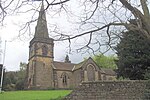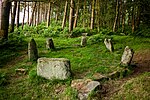Stanton Moor
Moorlands of EnglandMountains and hills of DerbyshireMountains and hills of the Peak DistrictPeak DistrictScheduled monuments in Derbyshire

Stanton Moor is a small upland area in the Derbyshire Peak District of central northern England, lying between Matlock and Bakewell near the villages of Birchover and Stanton-in-Peak. It is known for its megaliths – particularly the Nine Ladies stone circle – and for its natural, wind-eroded sandstone pillars. The Peak District Boundary Walk runs across the moor.
Excerpt from the Wikipedia article Stanton Moor (License: CC BY-SA 3.0, Authors, Images).Stanton Moor
Lees Road, Derbyshire Dales Stanton CP
Geographical coordinates (GPS) Address Nearby Places Show on map
Geographical coordinates (GPS)
| Latitude | Longitude |
|---|---|
| N 53.165 ° | E -1.63 ° |
Address
T55 large cairn
Lees Road
DE4 2LQ Derbyshire Dales, Stanton CP
England, United Kingdom
Open on Google Maps









